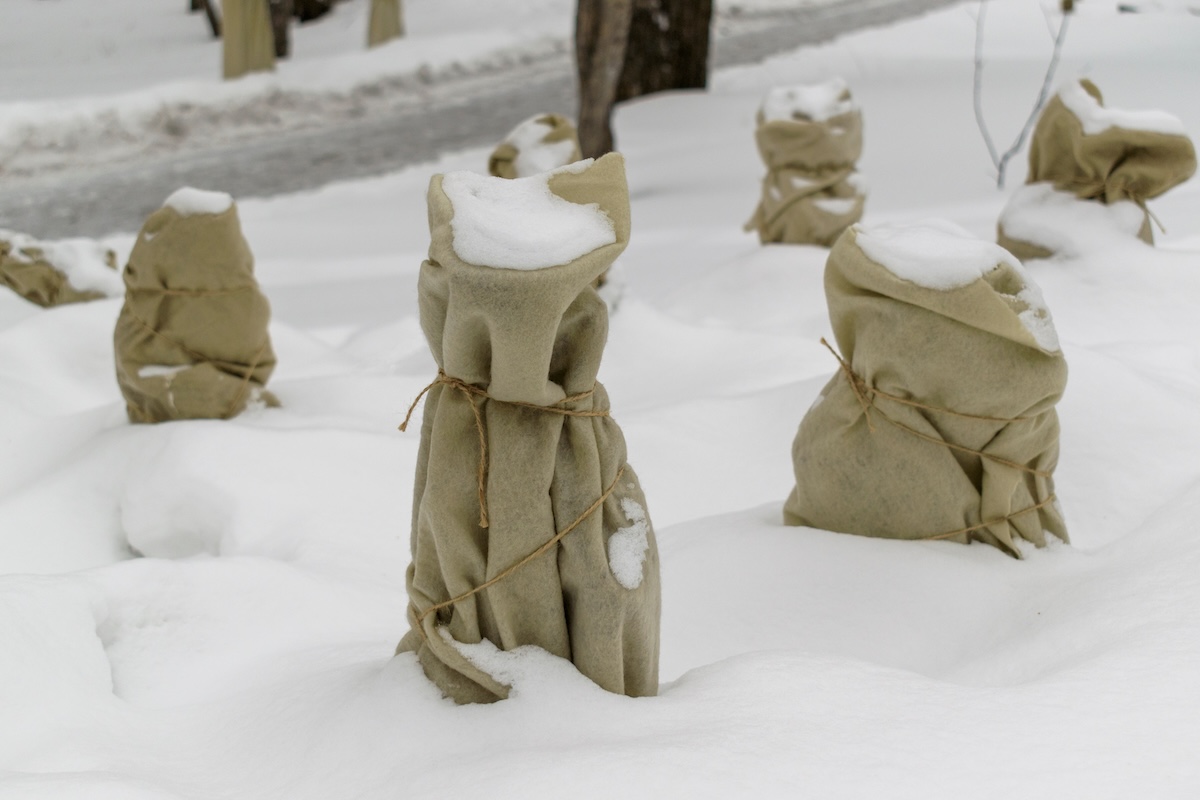

We may earn revenue from the products available on this page and participate in affiliate programs. Learn More ›
As the gardening season begins to wind down and first frost dates creep closer, it’s time to think about protecting your plants for the winter and extending the harvest. Plant covers can help plants survive longer, allowing you to harvest plants like spinach, kale, and lettuce well into the fall and even into the winter.
Plant covers also can protect plants from hungry pests looking for food sources as other sources begin to freeze over. And finally, plant covers can even help plants survive colder conditions than they’re used to.
The ideal time to grab plant covers and start protecting plants is when temperatures begin to dip overnight. Frequently checking the weather forecast ensures you’ll be at the ready with plant covers in hand. Here are some of the best plant protection options available.
1. Row Cover

There are two kinds of row covers you can get for the garden: fleece and plastic. Fleece covers help insulate frost-sensitive plants, but they’re also permeable and let in moisture. Conditions under plastic row covers can be significantly warmer than outside because clear plastic creates a greenhouse-like effect.
Gardeners can use both types to extend the growing season, but plastic works best for very cold climates. However, you’ll need to check on plants frequently to ensure they’re not overheating. Remember that you’ll need to secure both types of covers with stakes, rocks, or clips.
Row covers are also great for getting an early jump on the gardening season and protecting crops from pests.
Best For: Protecting edible crops and extending the gardening season
Our Recommendation: The floating row cover from AgFabric is available in multiple sizes and protects plants from wind, pests like grasshoppers, and surprise freezes.
RELATED: 14 Wise Ways to Weatherproof Your Garden
2. Tree Wrap

Picture a mummy. Now picture the young, thin-barked trees in your yard wrapped like they’re set to rest for eternity. Tree wraps are thin strips of either fabric, paper, or burlap that wind around tree trunks and keep trees safe from rapid freezing and thawing cycles that can cause severe damage.
Wraps also can keep animals at bay and prevent damage caused by rodents and other pests. Usually, gardeners apply the wraps at the end of the growing season and remove them in the spring. Still, some people like to leave them on all year round for constant protection. Wraps are handy for protecting newly planted trees that are still tender and vulnerable to fluctuating winter weather.
Best For: Protecting young trees and trees with thin bark
Our Recommendation: Rolls of DECHOS natural burlap tree wrap is 15.7 inches wide and almost 20 feet and are reusable and easily secured with rope or twine after secured around a tree trunk.
3. Burlap

Wrapping shrubs and trees in burlap can protect them from harsh winter conditions and keep them from going through dreaded winter burn. When evergreen plants get too much sun and don’t have access to enough moisture during the cold months, they can experience winter burn, which can turn foliage brown and severely affect plant appearance and overall health. Burlap is inexpensive, 100 percent biodegradable, and breathable.
Ideally, burlap shouldn’t touch the plants, so creating a tent-like structure with wooden stakes is the best strategy. This prevents wet burlap from freezing and damaging foliage and ensures the cover doesn’t blow away in the wind.
Best For: Protecting small trees and shrubs from winter burn
Our Recommendation: This 30-foot roll of burlap from Burloptuous is 40 inches wide and has a tight weave, so it should easily cover multiple plants in your garden.
4. Mulch

Mulch is one of the most versatile plant protection tools there is. In warm weather, it cools the soil. When the weather turns cold, mulch can help insulate plant roots. Mulch also helps conserve moisture and reduce watering needs. Organic mulches can even improve soil condition over time as they break down.
The key to using the right amount of mulch is not to apply too much of it—you don’t want to suffocate your plants. Add a layer around the base of a plant that’s no more than 4 inches thick. What can you use for mulch? Raked fall leaves, coco coir, compost, wood chips, straw, and shredded paper, and even gravel are all solid options.
Best For: Perennials that need minimal protection from chilly weather
Our Recommendation: If you’re not up to shredding your own paper mulch or gathering raked leaves, try FibreDust’s Coco Mulch, a type of mulch that’s made of shredded coconut husk. It is a nontoxic, organic option that looks as good as it is effective.
5. Cloches

Cloches are excellent temporary protection tools that protect tender plants from sudden frosts. Your first frost date might not be for a month, but sometimes, a random patch of cold weather can happen unexpectedly. Don’t panic! Grab some cloches and pop them over your most frost-sensitive plants so they can live another few weeks.
You can also use cloches for protection in the spring. The only downside to using these small, portable greenhouses is that they tend to be quite expensive, so they’re not ideal for protecting a large swath of plants or large shrubs.
Best For: Protecting a handful of tender plants in a small garden
Our Recommendation: Fshow garden cloches come in packs of 20, are made of transparent green plastic, and are 7 inches tall. They’re also vented, so you can rest easy knowing your plants can breathe.
6. Cold Frame

Yes, you can harvest some edibles over the winter, even when there’s snow on the ground. Perhaps the sturdiest of all plant covers, cold frames are typically made out of wood and glass and are hinged on one side so gardeners can check on plants and let in air on sunny days. Cold frames are the tool of choice for many winter gardeners.
The key is to time your plantings to ensure the plants are just about fully grown as the weather turns icy, since growth slows significantly during the cold months. Cold frames come in many different sizes and, if you’re handy, are relatively easy to DIY.
Best For: Fall and winter vegetable gardening in cold climates
Our Recommendation: The Giantex portable wooden cold frame measures nearly 40 by 25 by 15 inches and has polycarbonate windows. Your best bet, however, might be to build your own cold frame to save money and customize its size.
RELATED: The Best Greenhouse Plastic
7. Pop-Up Greenhouse

Pop-up greenhouses are temporary plastic structures designed to mimic the conditions of a greenhouse. Unlike permanent structures, pop-up units are more vulnerable to weather conditions like wind and snow. They’re ideal for warmer climates that don’t get much wind. When they’re placed in a sheltered area, a pop-up greenhouse offers an excellent spot for starting seeds or hardening off plants when spring arrives.
Best For: Mild climates and starting seeds in the spring
Our Recommendation: The Ohuhu Mini Greenhouse features four shelves and a sturdy steel frame. At the end of the season, the shelving unit is easy to break down for storage. It also made our short list of the best compact greenhouses for gardeners.
